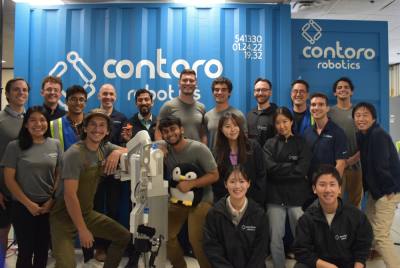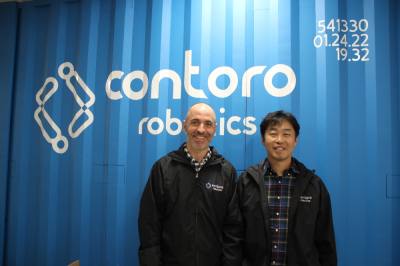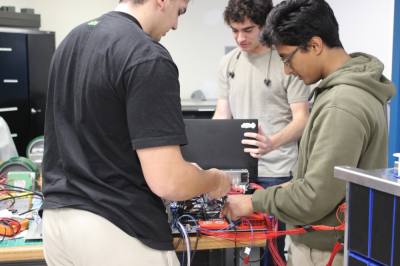Initially born out of a technology he helped develop and commercialize for hand and arm rehabilitation under Harmonic Robotics, Yun has forged a new path in warehouse operations with technology that could dramatically alter the industry: humanoid robots.
“At Contoro Robotics, we want to combine AI with human intelligence for better robotics control,” Yun said.
The breakdown
Founded in 2022, Contoro Robotics is a startup focused on automating the warehouse industry. As supply chain issues resulted in nationwide shortages in 2021-22, Yun and Business Development Manager John Cook took a deep dive into uncovering the problem.
“Companies have to rely on humans to take those boxes off and put them onto a pallet so that it can go through the next link in the supply chain,” Cook said. “During COVID[-19], we didn't have any labor, and everybody realized how vulnerable the supply chain was as a result.”
While Yun brings to the table a decorated background in mechanical engineering, Cook has over 20 years of experience in large-scale warehouse management. Together, the two have spearheaded a solution that could benefit companies and consumers alike.
“We visited many customer sites, ... and the customers basically echoed the same things,” Yun said. “There is a really big problem here, and we decided to solve this problem.”
How it works
The North Austin startup relies on the marriage of artificial and human intelligence in an effort to create reliable supply chains.
A machine with an industrial robotic arm uses AI to locate boxes, pick them up with suction and move them from shipping containers onto conveyor belts.
Meanwhile, a worker uses an exoskeleton suit to control the robotic arm remotely from Austin’s control center when necessary to fix any problems, such as dropped boxes. As human workers intervene, the human input will allow the AI to continue to learn and improve, Yun said.
This combination of AI with human intelligence ensures more reliable service for customers, Yun said.
The impact
Through testing, Contoro has found that AI alone performs well 98% of the time, but the remaining 2% of operations require assistance. With such high levels of self-sufficiency from AI, one teleoperator can monitor 10 robotic arms at once, Yun said, doing the job of 10 in-person workers.
Despite potentially altering those worker positions, however, Yun and Cook view the change as positive for workers and employers.
A typical worker would unload around 5,000 boxes per day weighing 20-40 pounds each, which poses a safety risk for employees, especially in Texas due to the heat, Yun said. Additionally, automating much of the process ensures companies get the supplies they need without relying on workers who may not show up that day, Cook said.
“Being able to elevate warehouse workers into other roles, rather than slogging it out working in a hot shipping container, I think is quite desirable,” Cook said.
Going forward
Despite being a relatively small technology startup, Contoro Robotics has multiple customers in Austin and beyond waiting to work with them, Yun said.
While the technology has been distributed to some customers on a smaller scale, the company plans to expand its operations in 2024 with six new robots, and eventually expand into Georgia, California and Tennessee, Yun said.
Though Contoro is now seeing larger-scale success, its roots are still local. Robotic parts are painted at CMT in Round Rock, while the shipping container used for testing is was commissioned from Zach Theatre. Additionally, Contoro has partnerships with Go! Retail Group and Amplifier, two Austin-based companies. The company loves giving back to Austin, Yun said.
“We try to use some local companies for partnerships,” Yun said. “We also like to help local institutions like [The University of Texas], where we donated some research labs to the students. Our money is from California and South Korea, so we are investing in the local community.”
- 1807 W. Braker Lane, Ste. C500, Austin
- www.contoro.com









